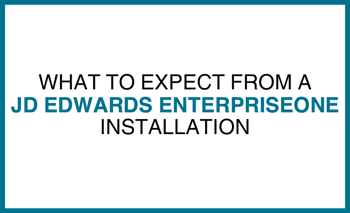Guidelines for a New JD Edwards EnterpriseOne Install
 Once you have made the decision to implement JD Edwards EnterpriseOne as your ERP system, there are a number of decisions that need to be made and steps that need to be taken. In order to fully optimize your EnterpriseOne environment, follow this high-level outline for a successful JD Edwards EnterpriseOne installation.
Once you have made the decision to implement JD Edwards EnterpriseOne as your ERP system, there are a number of decisions that need to be made and steps that need to be taken. In order to fully optimize your EnterpriseOne environment, follow this high-level outline for a successful JD Edwards EnterpriseOne installation.
Architecture Planning
Planning your architecture is arguably the most essential part of an EnterpriseOne install. There is no right answer when it comes to configuring JD Edwards; you can architect it to work with your business needs. The underlying architecture, however, will heavily impact the ability to support the business, so it’s important to get it right the first time around in order to prevent future rework.
Although the EnterpriseOne software itself is inherently platform agnostic, there are certain nuances that come with each platform when installing EnterpriseOne. Processes, commands, base settings, underlying security, and more will change between Linux, Windows, IBM i, and other platforms, but EnterpriseOne can be configured for each of them.
If you do not have an existing platform and need to choose one for the project, there are many variables to consider, including price, support requirements, and underlying security. Also, consider where your company’s in-house expertise lies. While things like budget play a big role in a platform decision, be sure to select something that your support staff (in-house or partner bases) is comfortable maintaining.
Oracle JD Edwards certification is another thing to keep in mind when selecting a platform. Oracle supplies a certification matrix for platforms and third-party programs, so make sure that whatever option you’re considering is certified. While EnterpriseOne will certainly run on a non-certified platform, Oracle can restrict the level of support available.
Having the proper architecting resources available from the beginning will ensure that your platform can support not only your current business model, but any potential future growth.
Software Installation
Installing the base EnterpriseOne software with a standard, out-of-the-box configuration and setup, which will provide enough functionality to allow users to log onto the system, takes about 40 hours. This does not include uploading data, it simply provides users with enough functionality to access the system.
Data Conversions
Once you have the software installed, you will notice that the base EnterpriseOne software is essentially a bare bones application. You receive only what Oracle delivers, which includes their code and development, their table structures, and demo data. In order to make EnterpriseOne work for you, you will need to input your company’s data. There are a few ways to go about this, but it will typically be either a manual process or a conversion from your legacy system.
Your data needs to come from somewhere, whether that’s a spreadsheet loaded into JD Edwards or an interface with your legacy application. Regardless of the source, there will need to be a data conversion on some level in order to load your company information.
Another option to consider is Oracle Business Accelerator (OBA), which is a rapid implementation tool that allows you to get EnterpriseOne up and running as quickly as possible.
User Training and Follow-On Tasks
With the software installed and your data converted, there are still a number of additional tasks required in order to optimize your EnterpriseOne environment:
- Determine if you need any custom modifications to support your business processes.
- Customize standard processing to fit the flow of your business processes.
- Create standard operating procedures to support the various business departments.
- Analyze recommended third-party applications to determine if they will benefit the business process and implementation.
- Be sure that you have all necessary EnterpriseOne, database, and operating system security in place.
- Determine how much training is required for which users and develop a training schedule.
- Establish recovery plans and data back ups.
- Determine your data retention policy, keeping in mind things like legal requirements, SOX compliance, archiving, and retention maintenance going forward.
- Establish a change management and software update policy. JD Edwards releases software updates at least monthly, and your company will need to determine how frequently to take those updates. Companies often don’t consider this until they require an update that results in nearly a full software upgrade, but could have been accomplished with an on-time software update.
- Decide on an overall maintenance plan going forward. There are maintenance requirements in the system that, if forgotten about, can impact the ability to support the product and will consume resources that could have been freed up had a maintenance policy been in place.
- Determine a plan for go-live support.
While the initial base, out-of-the-box implementation takes only about a week, when all is said and done, a JD Edwards EnterpriseOne install can take three months or longer. This is dependent on the size of the company, the amount of customizations required, and the amount of data and how it’s being transferred. The size of the company will determine the amount of training required and the number of users and amount of data being brought in. The more customizations that are required, the more time will be needed for development, testing, and training.
Regardless of the time spent, performing a thorough implementation will ensure that you have a flourishing EnterpriseOne environment for years to come.

